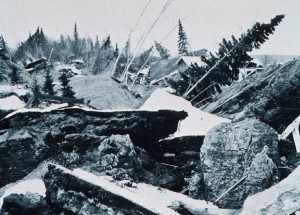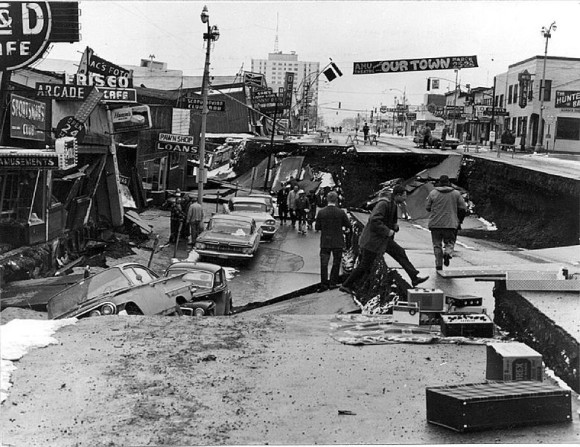This date in science: Biggest earthquake in North America
 After Good Friday Earthquake, in 1964 |
|
By Deborah Byrd and Elizabeth Howell in
Blogs | This Date in Science | Earth on Mar 27, 2015
March 27, 1964. On this date, at 5:36 p.m. local time, a 9.2 magnitude earthquake struck in the Prince William Sound region of Alaska, causing extensive initial damage and a subsequent tsunami. It had been a relatively warm day in Anchorage – Alaska's largest city, about 75 miles (120 km) from the quake's epicenter – and schools had been closed for Good Friday, along with many offices. In Anchorage, dozens of blocks of buildings were leveled or heavily damaged. The city of Valdez, closest to the epicenter, was completely destroyed. The quake came to be known as the Good Friday Earthquake. According to the U.S. Geological Survey (USGS), it was the biggest earthquake in North America – and second-biggest earthquake in the world as a whole – since modern seismometers came into general use around 1900.
The earthquake shook the land for nearly four minutes and caused many natural changes. The Latouche Island area, for example, moved to the southeast by nearly 60 feet (nearly 20 meters), according to the Alaska Earthquake Information Center (AEIC). USGS now estimates the March 27, 1964 earthquake and tsunami caused $311 million in damages across the state of Alaska.

During the 1964 Good Friday Earthquake in Alaska, both human and natural areas sustained damage. A large landslide caused the damage shown here to many homes in Anchorage's Turnagain-By-The-Sea subdivision. Image via U.S. National Oceanic and Atmospheric Administration/Wikimedia Commons.
And yet loss of human life was very small. Only 130 people were killed. AEIC said the low death rate was:
… due to low population density, the time of day and the fact that it was a holiday, and the type of material used to construct many buildings (wood).
The 1964 Good Friday Earthquake didn't come close to the loss of life from two slightly smaller and more recent quakes: the December 26, 2004 Indian Ocean 9.1-magnitude earthquake and tsunami (third-largest earthquake recorded on a seismograph, with over 230,000 people in 14 countries killed) and the March 11, 2011 9.0-magnitude earthquake in Japan (fifth-largest earthquake recorded on a seismograph, with nearly 16,000 deaths).
In 1964, Alaska was sparsely populated. Today's Alaska has a larger human population. If and when a similar quake strikes again, the death toll may be higher.

Damage to Fourth Avenue in Anchorage, Alaska, caused by the Good Friday Earthquake. The sidewalk on the left started out at the level of the street on the right. Image via Wikimedia Commons.
Click here for a good account of the 1964 Alaska earthquake.
Click here for more photos of the 1964 Alaska earthquake.
Bottom line: On March 27, 1964, the biggest earthquake known to have struck in the United States struck in Alaska. It is now sometimes called the Good Friday Earthquake. The death toll was low, but damage to both human structures and natural areas was high.
--
__._,_.___


No comments:
Post a Comment